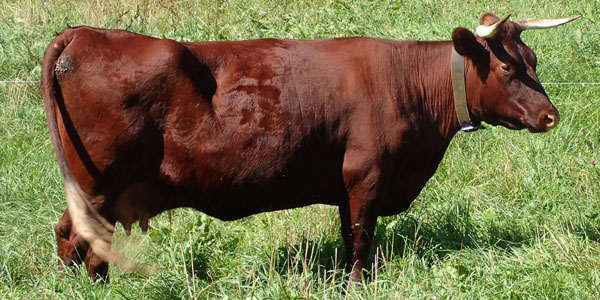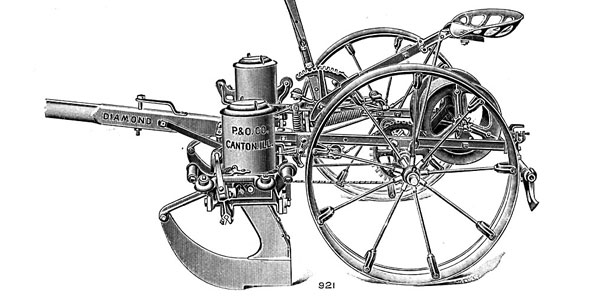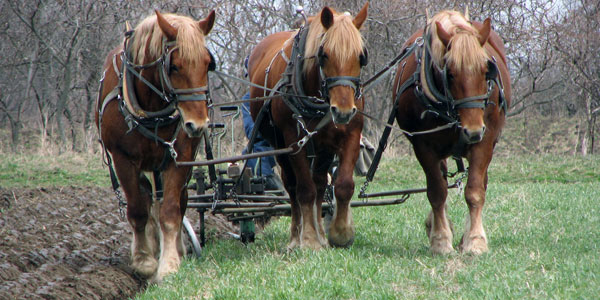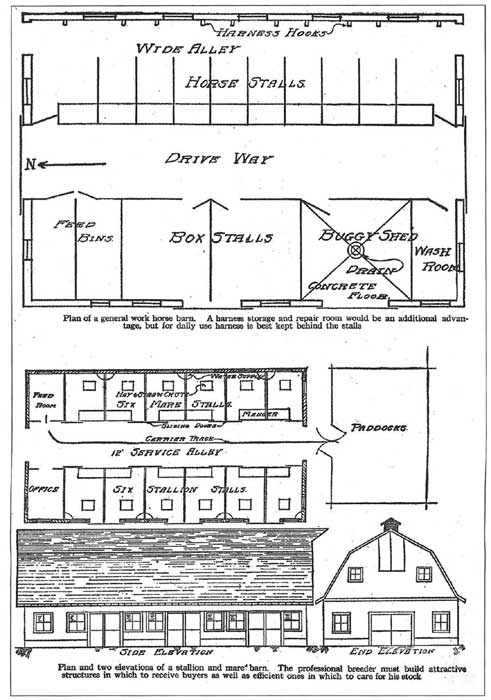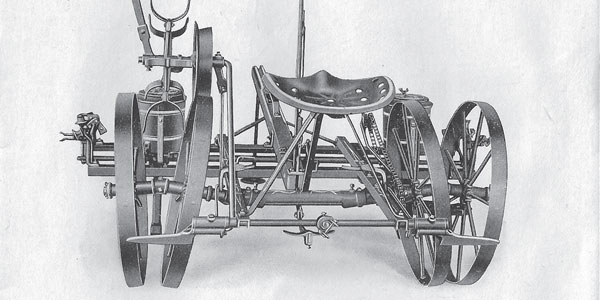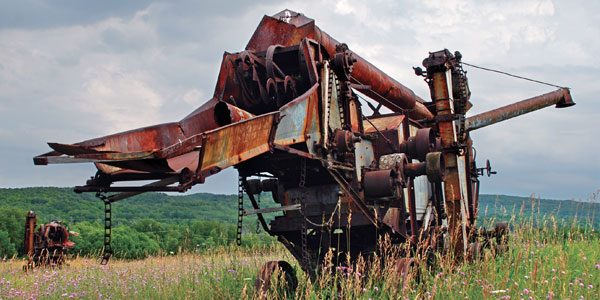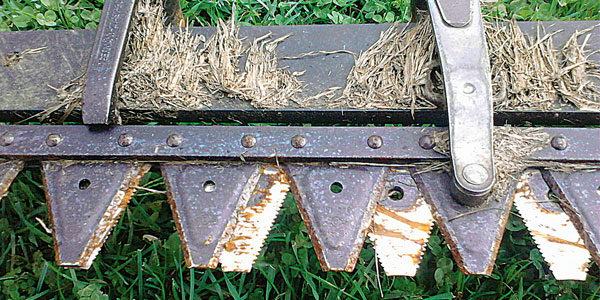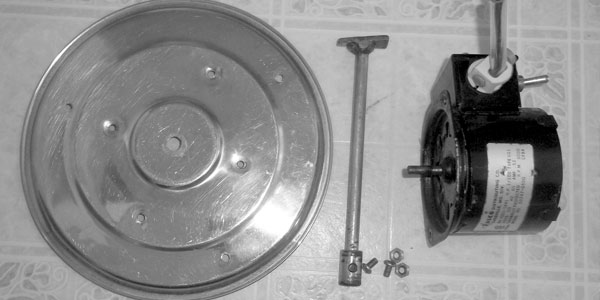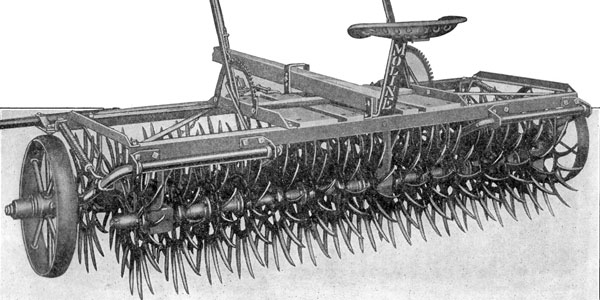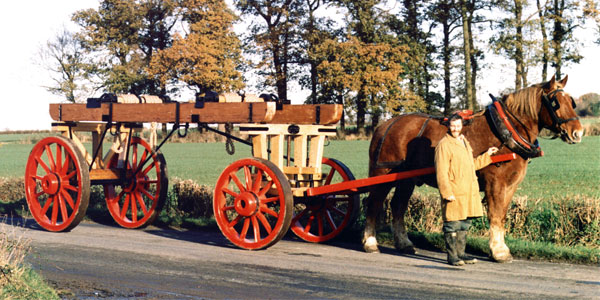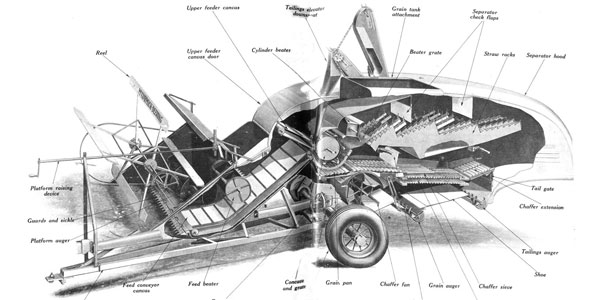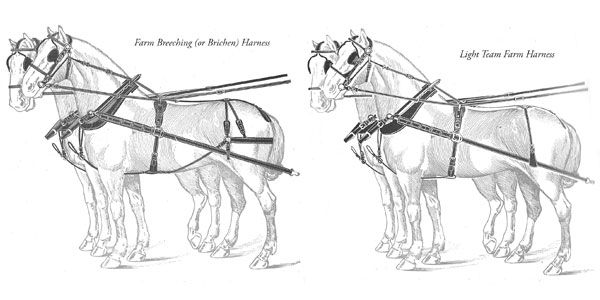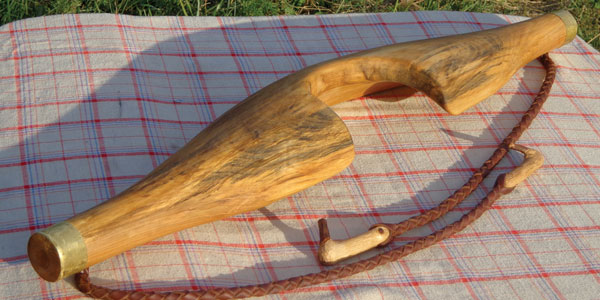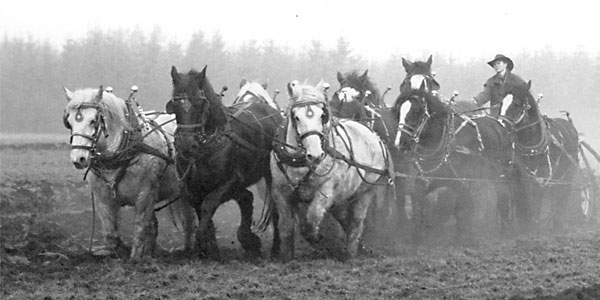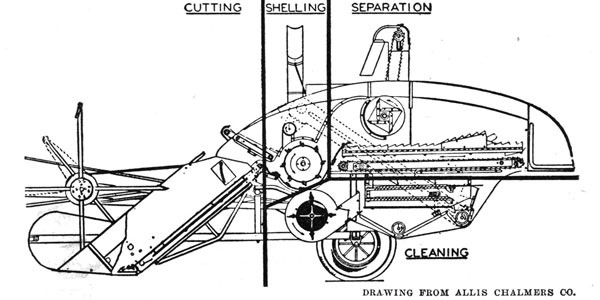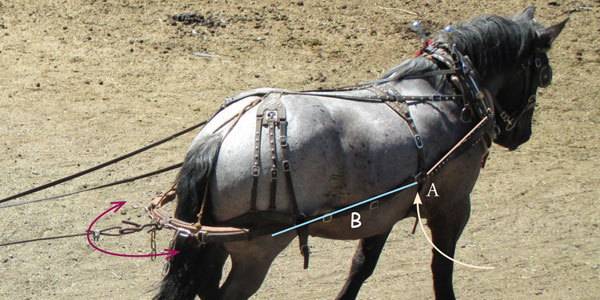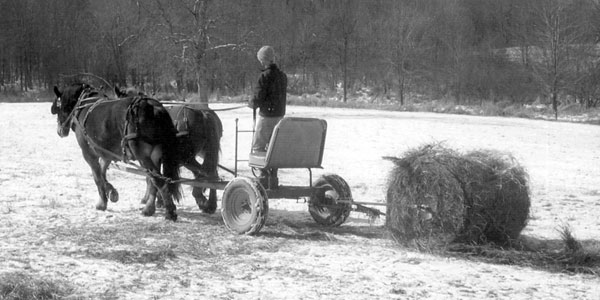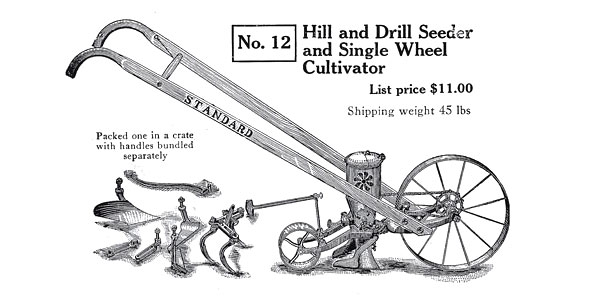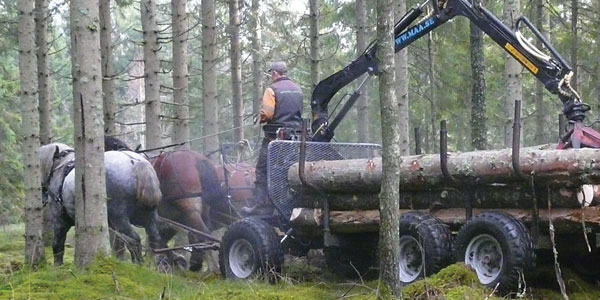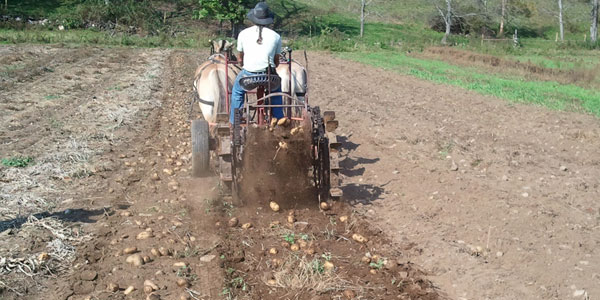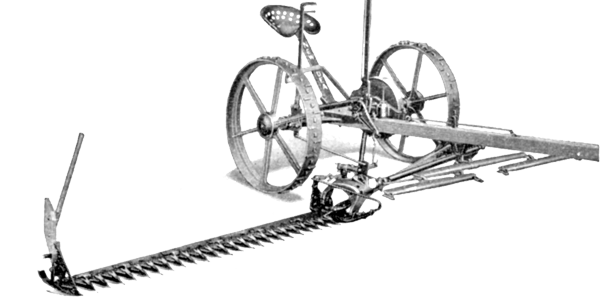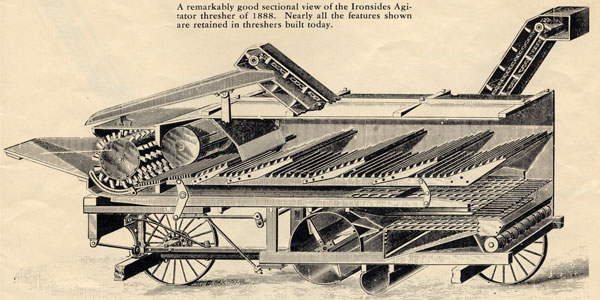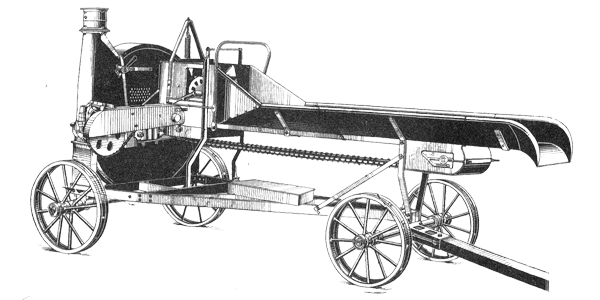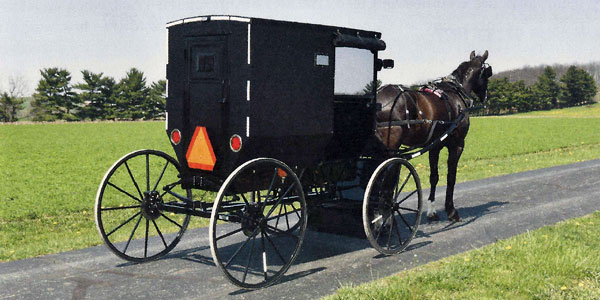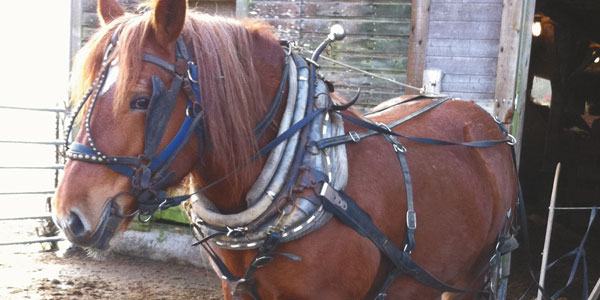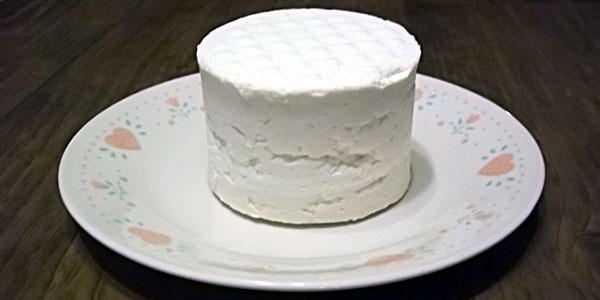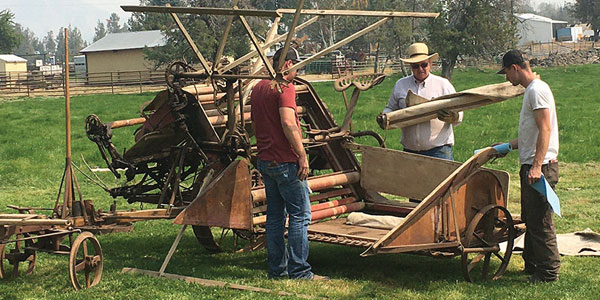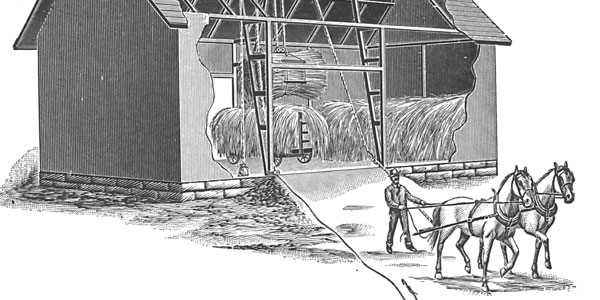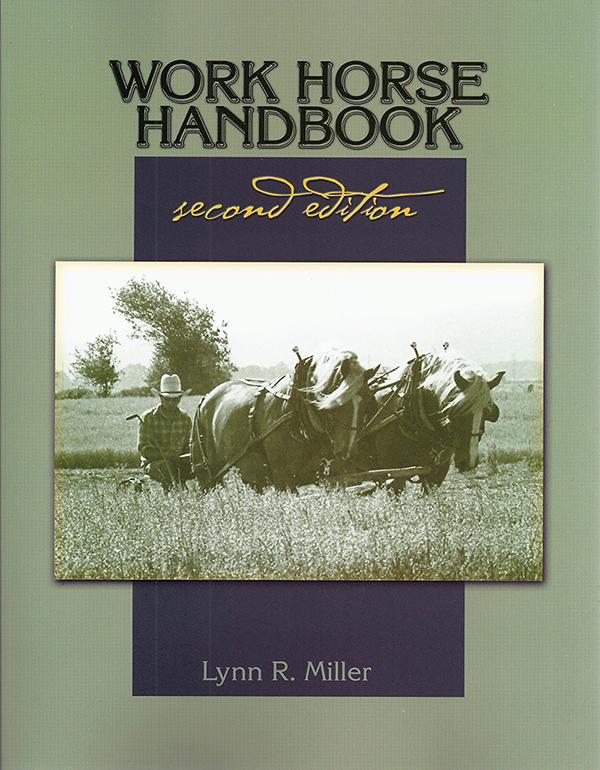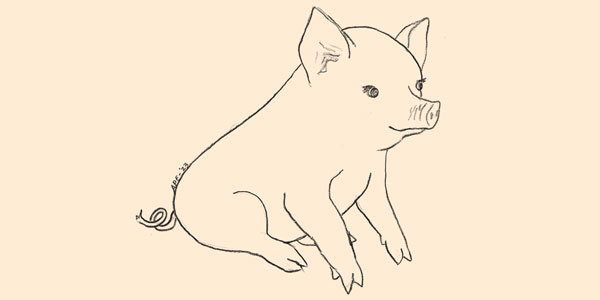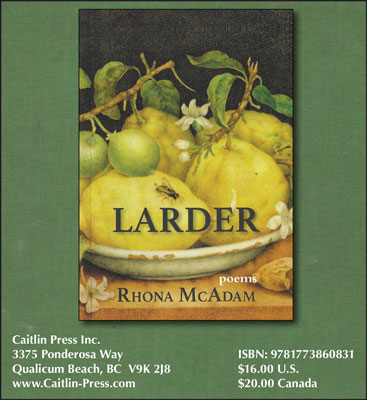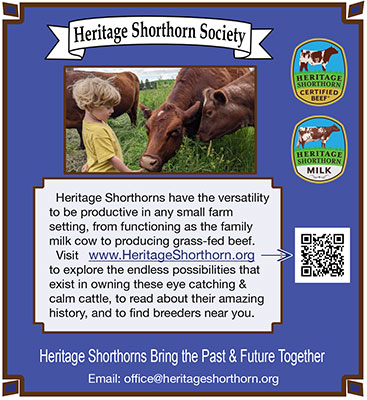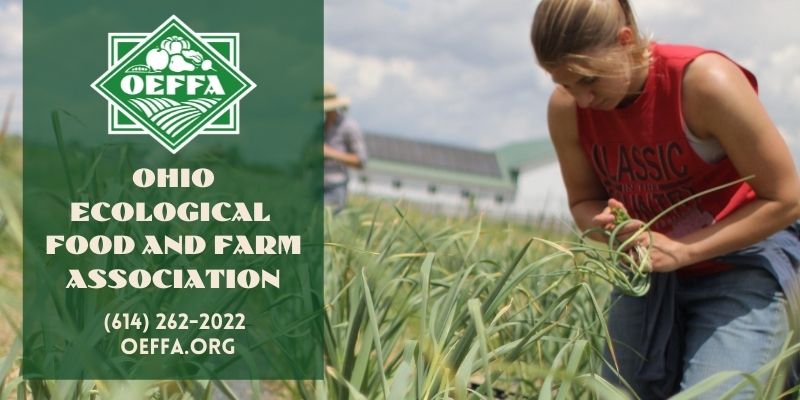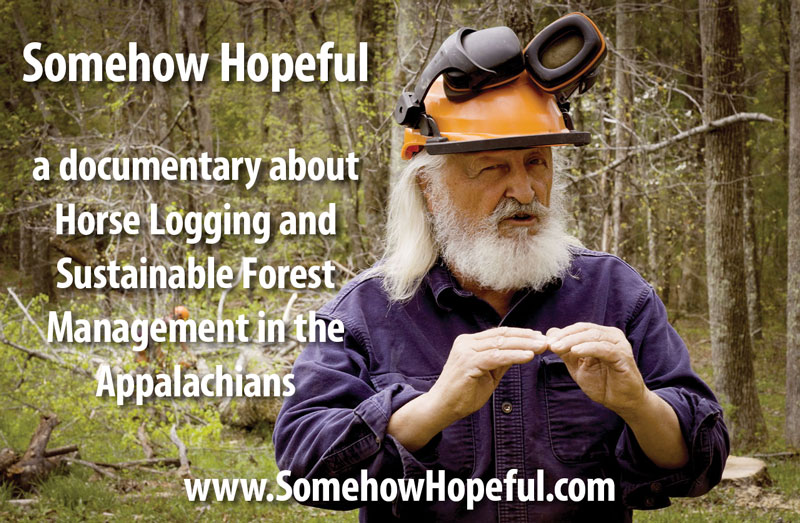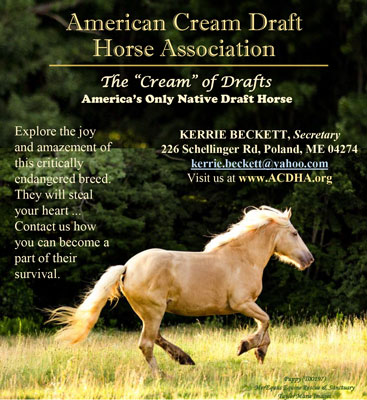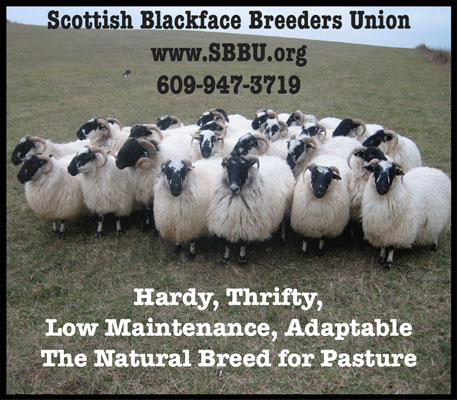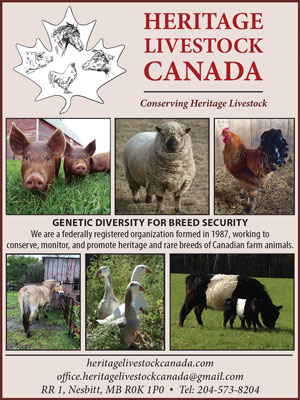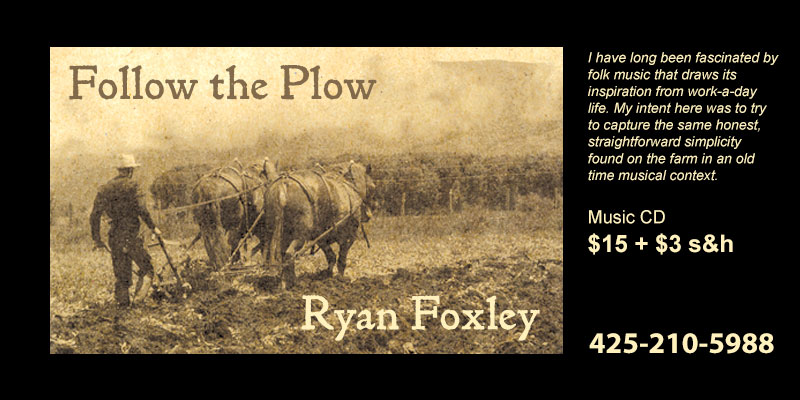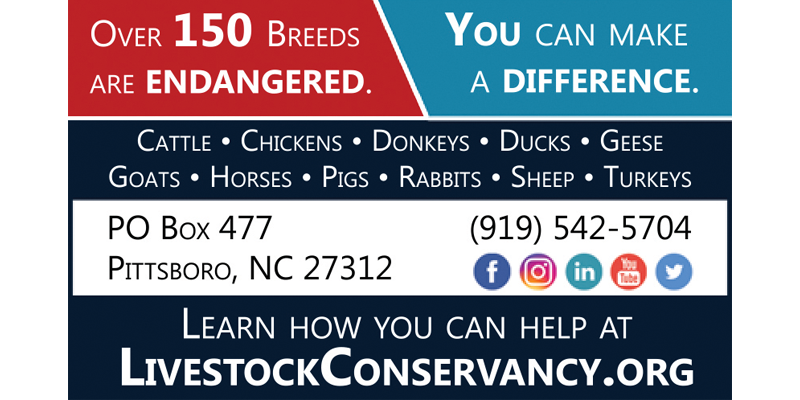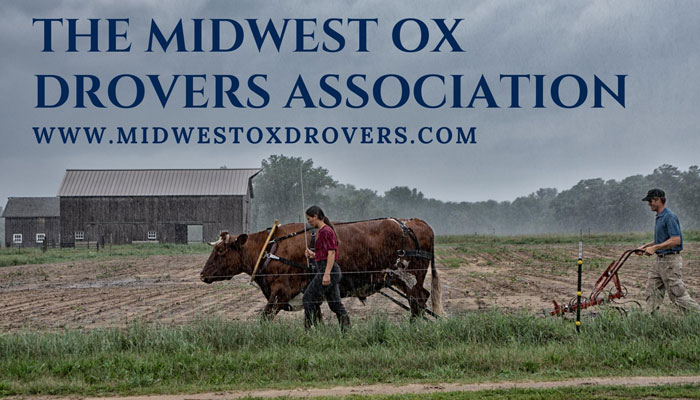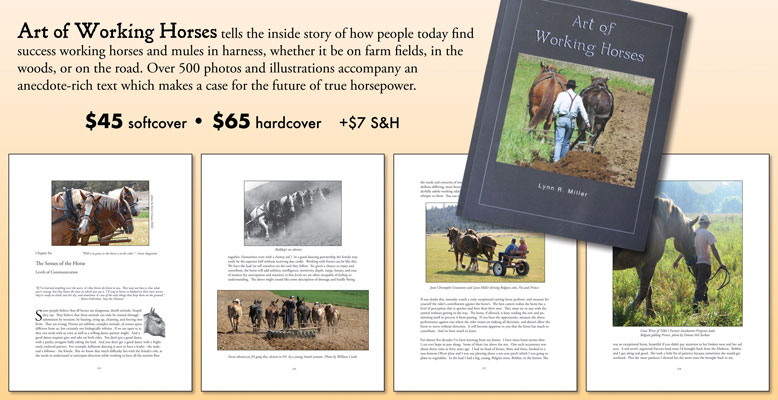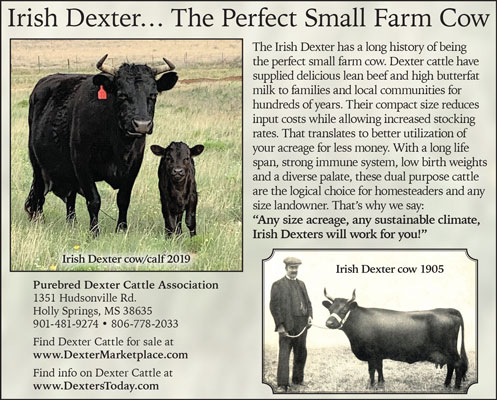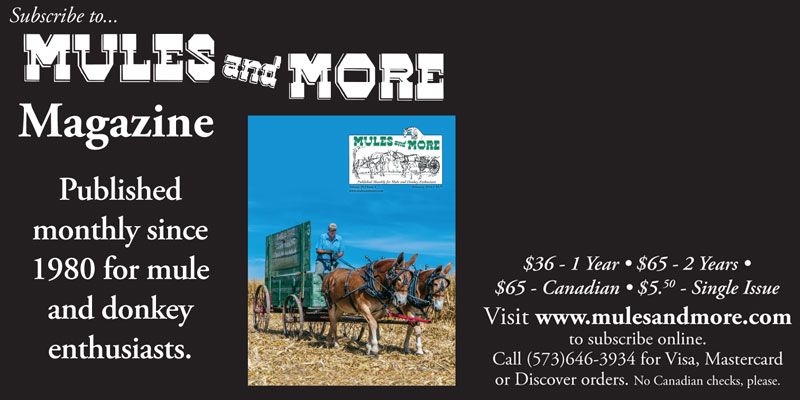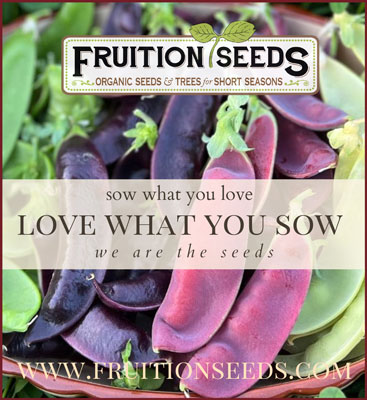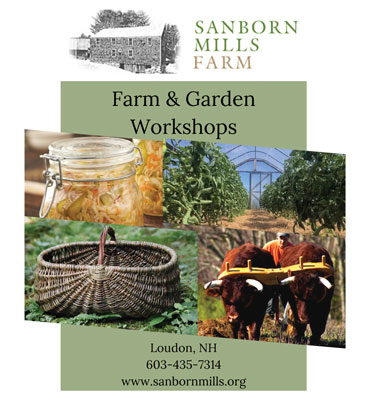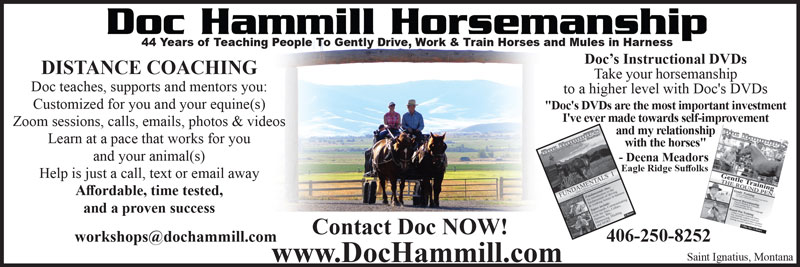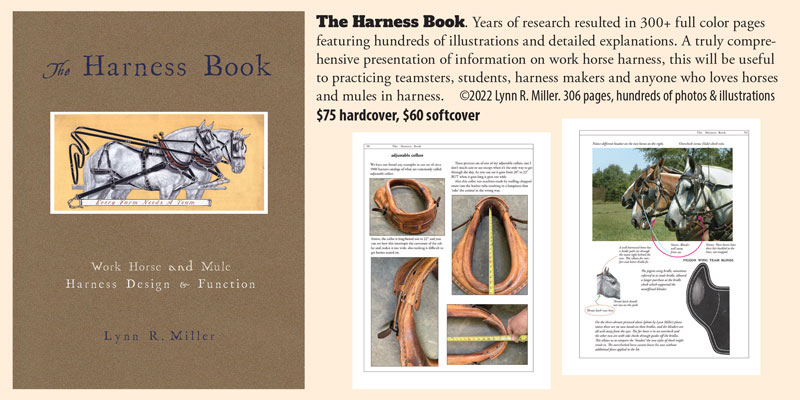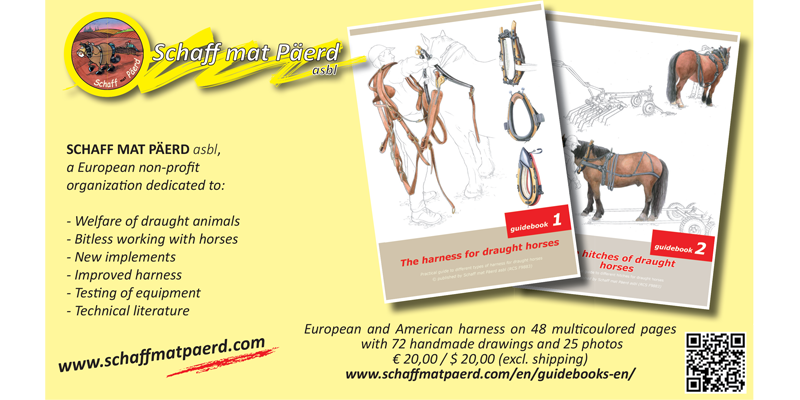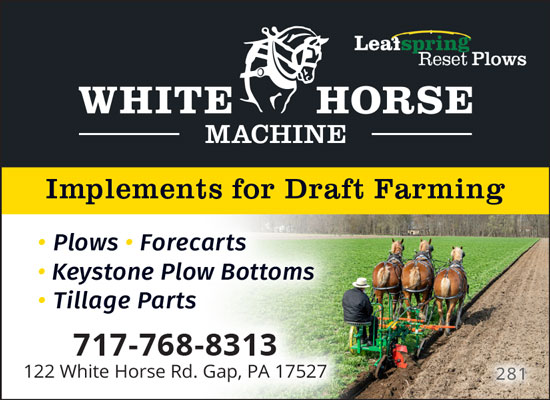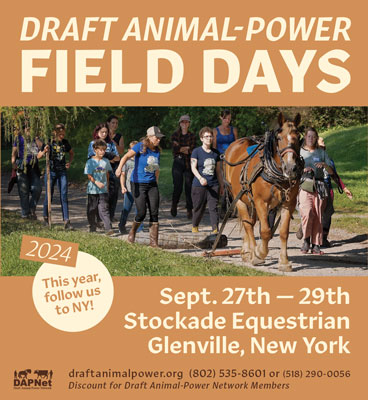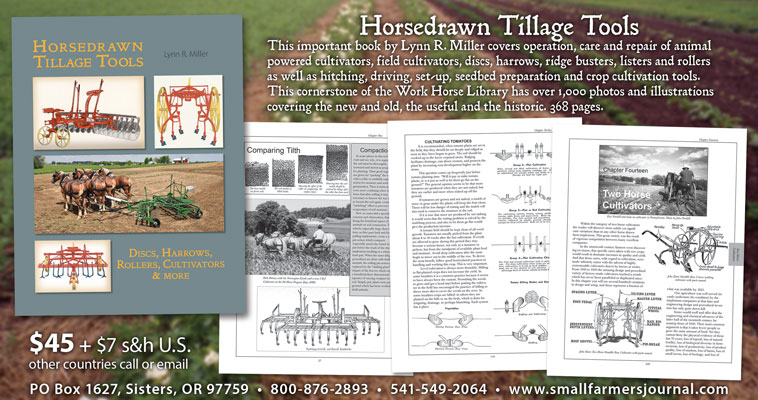MONDAY
April 15, 2024
Ground Driven PTOs
One of the ways tractors both gained and maintained their appeal is from the wider range of machinery they can power with the PTOs they carry. This definitely gave them the advantage over draft power. But is it going to stay that way? It may not have to be on a small farm. During the horsepower road trip Khoke and I went on a couple years ago, we got to see some examples from folks who knew which side of the fence they were on. We saw a number of machines that were reworked and reinvented to make them run off the power source of their choice, namely horsepower.
TUESDAY
April 16, 2024
Headlight Grape
One of the things long desired by Southern fruit growers is a good table grape, sufficiently resistant to leaf and fruit diseases to endure the climatic conditions of their section. Many varieties have been brought forward from time to time; but of the older sorts especially adapted to table use not one, either foreign or native, has yet proved successful over any large area. One of the most promising recent introductions in this field is the Headlight, which was originated by Prof. T.V. Munson, of Denison, TX, in 1895.
WEDNESDAY
April 17, 2024
John Deere Model HH Spreader
Check the adjustments on your spreader and make sure they are in proper operating condition. Hitch your team to the empty spreader to limber it up and see that it is working properly before loading. If you will turn the beaters over by hand before starting to the field, the spreader will start easier and will prevent throwing out a large bunch of manure when starting.
THURSDAY
April 18, 2024
Lost Apples
The mindboggling agricultural plant and animal diversity, at the beginning of the twentieth century, should have been a treasure trove which mankind worked tirelessy to maintain. Such has not been the case. Alas, much has been lost, perhaps forever. Here are images and information on a handful of apple varieties from a valuable hundred year old text in our library.
FRIDAY
April 19, 2024
American Milking Devons and the Flack Family Farm
On a sunny early September day I met Doug Flack at his biodynamic and organic farm, just South of Enosburg Falls. Doug is an American Milking Devon breeder with some of the best uddered and well behaved animals I have seen in the breed. The animals are beautifully integrated into his small and diversified farm. His system of management seems to bring out the best in the animals and his enthusiasm for Devon cattle is contagious.
Are you getting the SFJ Home & Shop Companion?
The Home & Shop Companion is a free weekly email newsletter. It features stories, handy hints, recipes, news, offers, projects, distractions and other stuff we think you’ll find interesting. The entire series is archived here on the website and is free to all to browse: Home & Shop Companion Archive.
SIGN ME UP FOR THE HOME & SHOP COMPANION!
Explore Small Farmer's Journal: Equipment & Facilities
P & O Corn Planters
Perfection in dropping corn is what is most desired by all farmers, and we claim, without fear of successful contradiction, that, in the Diamond Planter, we have the most perfect planter made, not only in respect to accurate dropping, but also in convenience and durability – two other very important considerations. We have made a careful study the past season of the fields planted with the Diamond Planter, and those planted with other planters, on some of which the manufacturers are making great claims of “accurate dropping,” and the results only strengthen us in our position that the Diamond has no equal.
Fjordworks: Plowing the Market Garden Part 2
Within the context of the market garden, the principal aim for utilizing the moldboard is to initiate the process of creating a friable zone for the root systems of direct-seeded or transplanted cash crops to establish themselves in, where they will have sufficient access to all the plant nutrients, air, and moisture they require to bear successful fruits. To this end, it is critical for good plant growth to render the soil into a fine-textured crumbly condition and to ensure there is no compaction within the root zone.
Profit by Better Threshing
This is from a brochure for the J.I. Case Threshing Machine Co. It has an excellent diagram of a threshing machine.
Blacksmithing: Plow Work
To sharpen plowshares without aid, the tool to use is a heavy hand hammer with a rounding face. With such a tool it is possible to draw the share out to a thin edge by pounding on the upper side, at the same time keeping the bottom straight by holding it level on the face of the anvil. Drawing the edge out thin has a tendency to crowd the point around too much “to land.” This tendency should be corrected from time to time as the drawing out process progresses, by holding the edge against a hardwood block and driving the point back to its proper position. Of course it would dull the edge to hold it against the anvil while doing this straightening.
Shed and Barn Plans
Below is a short piece from Starting Your Farm, by SFJ editor and publisher Lynn R. Miller. Click the links below to see Chapter One of Starting Your Farm and to view the book in our online bookstore. “You may have purchased a farm with a fantastic set of old barns and sheds. You, on […]
Blue Star Corn Planters
The more popular makes we know or have heard of, JD, McD, Case, Oliver etc., but it would be a mistake to assume that their’s were the only serviceable makes of planters from a hundred years ago. Fact is, most innovation and engineering daring came from the smaller companies which were swallowed whole or just disappeared. (Think of Studebaker, Tucker or Hudson?) LRM
New Life for an Old Barn
When we see an old barn that has fallen into ruin or that has been torn down to put up a new pole barn or other building, it just about breaks our hearts. So when we started talking about what kind of buildings we wanted on our twenty-three acres (there were none) my husband, Brian, and I decided we wanted to try to find an old post and beam barn to dismantle and rebuild instead of a pricey, new-fangled pole barn which we couldn’t afford.
Illusive Herd of Threshasaurus Sighted
The Threshasaurus’s large size and curious nature may appear antagonistic, but they are mostly curious and largely non-threatening. Be careful when approaching, however, as they do have sharp teeth and many fast moving, exposed pulleys.
Gies’ New-Made Hayloader
I was sitting on a 5 gallon bucket staring at the hayloader. I had a significant amount of time and money invested. My wife, the great motivating influence in my life, walked up and asked what I was thinking. I was thinking about dropping the whole project and I told her so. She told me that it had better work since I had spent so much money and time on it already. She doesn’t talk that way very often so I figured I had better come up with a solution.
Mower Conversion
About 10 years ago, I began hearing about the German ESM “Busatis bidux” cutterbar sold by I & J Mfg. It seemed that everyone was impressed by the double acting sickle bar and I couldn’t help wondering if it would improve the mowing action of my ground drive mower in my soggy, fine-but-wiry summer grass.
Eggs & Their Care
Egg quality is the combined elements of an egg which increase the market value to the producer, the keeping qualities to the distributors, and the nutritive and eye-appeal value to the consumer.
Build Your Own Butter Churn
Fresh butter melting on hot homemade bread… Isn’t that the homesteader’s dream? A cheap two-gallon stock pot from the local chain store got me started in churn building. It was thin stainless steel and cost less than ten bucks. I carted it home wondering what I might find in my junk pile to run the thing. I found an old squirrel cage fan and pulled the little motor to test it. I figure that if it could turn a six-inch fan, it could turn a two-inch impeller.
Rotary Hoes vs Cultimulchers
Some years ago I was involved in discussions at Horse Progress Days about the new cultimulchers that several companies were making. One old farmer, almost as old as I, said those weren’t cultimulchers. His dad had used a Moline ‘cultimulcher’ and it looked nothing like these. While it is true that Moline made a tool called a rotary hoe which they said cultivated while making a surface mulch, is it the same? Well here, straight from their original catalog, we offer Moline’s candidate. You decide.
A Step Back in Time with the Barron Tree Planter
The 18th century saw a tremendous interest in landscaping private parkland on a grand scale with the movement of entire hills and mature trees, all by man and horse power, to fulfill the designs of celebrated gardeners such as Capability Brown. In the mid 1800s the movement of mature trees was revolutionised by the introduction of the Barron tree transplanter. The first planter was designed and built by Barron for the transplantation of maturing trees at Elvaston Castle in Derbyshire.
McCormick-Deering No. 62 Harvester-Thresher
Since the conditions encountered in the field are so varied that definite instructions would be of little value, the aim is to explain the effect of certain adjustments and leave it to the one making the adjustments to determine when they should be made. Determining the cause before attempting a remedy will simplify the task. Study the problem carefully before making any changes. There are four principal units in the Harvester-Thresher: The Heading, Threshing, Separating and Cleaning Units. Each should be considered individually to determine where loss of efficiency may be present.
Making a Wooden Neck Yoke
This old-time neck yoke is a simple carved wooden piece with strings and hooks that is placed on a person’s shoulders for carrying buckets. I use my yoke for hauling water for our sheep, bringing collected maple sap back to storage containers, and supplying fresh cold well water to our home. When buckets need to be carried over any distance, this yoke does a wonderful job transferring the buckets weight from your hands and arms to the top of your shoulders. My grandfather made the pattern and showed me how to make one. This style of neck yoke has been used in my family and among friends for three generations. It is considered a valuable tool in our homesteading lifestyle.
Happ’s Plowing: A Chance to Share
Dinnertime rolled around before we could get people and horses off the field so that results of judging could be announced. I learned a lot that day, one thing being that people were there to share; not many took the competition side of the competition very seriously. Don Anderson of Toledo, WA was our judge — with a tough job handed to him. Everyone was helping each other so he had to really stay on his toes to know who had done what on the various plots.
Combine Adjustments
Most of the grain losses from combine operation can be prevented if the grain is ripe enough when it is cut and if the machine is correctly adjusted. The machine should be adjusted for each field that is cut and adjusted several times each day for changing weather conditions. Good operation of the combine is difficult where there is a large proportion of weeds in the crop, but correct adjustment reduces the trouble. Grain loss may be at the following places: the grain platform (reel or cutter bar), the cylinder, the straw rack, and the cleaning shoe.
Work Horse & Mule Harness Design & Function Part 3
The tugs, from their attachment to the hames usually traveling back along the animal, best perform at an angle of 80 to 100 degrees to the line of the hames. If the angle is significantly less than 80 degrees the tugs may pull up and back on the collar, but only if the belly band is not adjusted properly. When it is, this will ‘interrupt’ an aggravated angle preventing the horse from being choked by a forward rocking collar. If the belly band is too loose it won’t hold the forward portion of the tug in line. As each and every horse’s angle of shoulder is different, and as the head-set of a pulling horse may be more or less down or up, these factors will affect the angle of the shoulder at work.
G Haw Tool Carrier
After several years of thinking about and planning a concept design for a tool carrier that could handle our cultivation needs, we began to see the possibility of a horse drawn cultivating and implement tool carrier design based on a combination of several implements we either had on the farm or could use as inspiration for critical design functions for the tool to be successful.
Hay Making with a Single Horse Part 4
Over the last few years of making hay, the mowing, turning and making tripods has settled into a fairly comfortable pattern, but the process of getting it all together for the winter is still developing. In the beginning I did what everyone else around here does and got it baled, but one year I decided to try one small stack. The success of this first stack encouraged me to do more, and now most of my hay is stacked loose.
Moving Hay
Baled hay requires about 400 cubic feet to store a ton. A draft horse can easily eat 5000 pounds or about 1000 cubic feet of hay in a year, even if pasture is available in the summer. This would fill a 12 foot by 12 foot room seven feet deep. Weight of hay is also a consideration as anyone who has stacked square bales on a wagon behind a baler knows. Confronted with these big volumes of heavy stuff we recently converted most of our hay making from square bales to round bales. This greatly reduced the labor to get the hay bales, but left us with new questions about hay handling and feeding.
The Standard Garden Tool Company
The top two thirds of these pages features a reprint of the circa 1905 catalog from the Standard Garden Tool company. Across the bottom third of those pages we are running some of the illustrations of cultivator shovel setups from Lynn R. Miller’s Horsedrawn Tillage Tools. This book, originally published in 2001, has been out of print for 19 years. We are pleased to announce that it is once again available.
John Deere-Syracuse No. 210 Sulky Plow
The John Deere-Syracuse No. 210 Sulky Plow is acknowledged to be the lightest-draft plow of its type. It does an extra good job of plowing in any kind of soil and under all conditions. It runs level and plows at uniform depth, always — even when turning square corners. It’s the all-wheel-carried plow that has established its superiority wherever the use of this type of plow is practical. The advantages of the No. 210 over the ordinary sulky are many. The special design of rolling landside, and the fact that the plow can be used with either the Syracuse or John Deere clean-shedding bottoms are features responsible for the extremely light-draft and good working qualities of the No. 210 in a variety of conditions.
International Manure Spreaders (No. 1 and No. 2)
In order to get the best results both as to spreading manure evenly on the ground and to avoid heavy draft, the machine should be loaded at the forward end of the box first, and continue loading toward the rear until the cylinder is reached, being careful not to force the manure against the cylinder. This will allow the cylinder to start easily and the machine will draw much easier when loaded in this manner, the manure being more easily separated.
Iowa Wagon Builder
“I found the undercarriage from a hearse in Brookings, SD. The spindles still had the factory name stamped on them, so it wasn’t used very much. But the wood was all rotten so that all had to be replaced. Loren and I worked together on it over about a year and a half. I did the undercarriage and he did the body. It’s all made out of solid walnut that we cut in the area and planed.”
Upgrading Horse-Drawn Logging Wagons
The fact that electric or hybrid passenger cars, and even electric powered agricultural implements like GPS-guided precision seeders and planters, are promoted by the media and politics now, could tempt us to jump on this bandwagon and further develop other hybrid technologies for animal traction. However, taking into consideration the current discussions about the sustainability of battery production, their life cycle and recycling, as well as the environmental impact of electricity generation in general, we would partly give up some of the main arguments for the use of work horses, which are their 100% renewability on a local level, and their eco-friendliness, compared to any other source of motive power currently available in our high-tech world.
Fjordworks: Horse Powered Potatoes Part 2
These types of team implements for digging potatoes were the first big innovation in horse powered potato harvesting in the mid-19th century. Prior to the horse drawn digger the limitation on how many potatoes a farmer could plant was how many the farm crew could dig by hand. The basic design of these early diggers works so well that new models of this type of digger are once again being manufactured by contemporary horse drawn equipment suppliers.
New Idea Mower
For proper operation the outer end of the cutter bar should lead the inner end when the machine is not in operation. After long use the cutter bar may lag back and if this happens it can be corrected by making adjustments on the cutter bar eccentric bushing as follows: First making sure that the pin and bolt in the hinge casting “A” Fig. 5 are tight and in good condition.
Scotch Carts, Case Steam & an Ironsides Agitator
Scotch Carts, Case Steam & an Ironsides Agitator
John Deere Portable Bridge-Trussed Grain Elevator
When bolting the sections of elevator together be sure the upper trough ends overlap the upper trough ahead, and each lower trough is underneath the trough ahead, so the chains will slide smoothly. Bolt the short tie plates to the underside of troughs at the embossed holes in the middle of trough. When bolting on the head section, have the end of scroll sheet underneath the upper trough section. The lower cross plate in the head section must bolt on top of the return trough.
McCormick-Deering Wagon Offset Hitch
The information in this article may appear so specific that it escapes application for most folk, but we have discovered that this sort of detail can work to spur the ingenious farmer and shade tree mechanics towards far flung remedies to seemingly unrelated applications. In this case the material is very specific to the challenge of attaching an offset wagon to the back of a pto or ground drive corn binder so that the harvested crop may be gathered in the same field pass. The geometrical solutions to the offset draft are amazing. Where else would one find such information but in your Small Farmer’s Journal?
McCormick-Deering Ensilage Cutter No. 12B
IMPORTANT TO McCORMICK DEERING OWNERS: This pamphlet has been prepared and is furnished for the purpose of giving the user as much information as possible pertaining to the care and operation of this machine. The owner is urged to read and study this instruction pamphlet and if ordinary care is exercised, he will be assured of satisfactory service.
A Hidden Treasure
When David and Gus visited Mr. Hemmett they had an unexpected find. Not only was there the small tip-cart but other full sized farm wagons. The first that David looked at was a double shafted Lincolnshire wagon designed for the flat lands of that county and too big and heavy for his Suffolk mare of 16.2 hands. But tucked at the back under a tarpaulin was the ideal vehicle – a Norfolk wagon that could take either a single or double shaft and was suitable for the smaller draught horse.
New Buggy Gear Design
As long back as most of us can remember, the plain people were using buggies for transportation. Buggy frames were mounted atop wood wheels that turned on large solid steel axles. Today, more new technology is available for buggies. Torsion axles, fiberglass and steel wheels, hydraulic disc brakes, LED lights, and sealed batteries — the list could continue.
Hay Barns & Sheds and Corn Shellers
Hay Barns & Sheds and Corn Shellers
Rebuilding a 7-Sweep Horsepower Unit
Once upon a time there were no gas (or steam) powered motors. Necessity begets innovation and every discovery simply lays the foundation for the next. Mechanization arose, yet for a long time the only power sources were a person’s two hands or the four legs of a draft animal. An under appreciated amount of hand and draft powered machinery came to be. Among these were horsepower units. A set of gears set in motion by a draft animal walking a circular track pulling a tongue.
LittleField Notes: Pineapple Express
When I opened the kitchen door early this morning I was met by warm humid air and the sound of torrential rain. A monsoon, I thought. It’s what North-westerners call a “Pineapple Express,” a warm atmospheric river that follows the jet stream straight from Hawaii. The moisture laden clouds stack up against the Olympic and Cascade Mountains and the sky lets loose. It’s not uncommon for mountain areas to receive 5-10 inches of rain in a 24-hour period. Littlefield Farm sits in the foothills of the North Cascades and is a mighty wet little corner of the world. With 60 or more inches of rain at the farm annually, we are in the midst of only a handful of temperate rain forest regions of the world.
A Good Day Mowing at the Lazy M Ranch
There were two irrigated fields, adjacent to one another, and totally 25 to 30 acres. With only a couple of minor mechanical adjustments we mowed pretty much uninterrupted (except for water breaks and photo ops) and finished the job in under 3 hours. (For those of you who are interested in the applied math: These outfits can cover 9 to 10 acres each in one day. Using 9 as an average that means these 5 mowers can drop 135 acres of hay in three days.) Mike told me that when the hay was ready Nick would spend a six hour day with forecart and rake just ahead of the baler.
Pioneer Foot-lift Sulky Plow
The lifting mechanism for this plow is a foot-operated lever which allows the operator to use both legs for lifting and setting. This foot-operated action means the operator can keep his hands on the lines at all times. The steering tongue means the plow will turn sharp on headlands for safety and efficiency. It also provides assurance on hilly terrain or with new horses, that the plow will not run up on their heels. Levers on both sides permit the operator to set the frame level for accurate plowing.
McCormick-Deering Two-Row Potato Planter
After having worked the machine and previous to starting it again, see that the pickers move freely and are free from starch and dirt from the potatoes. When turning corners, raise the furrow openers by means of the raising levers, which also raises the covering disks. The marker should be raised when not in operation to prevent danger of breaking.
Homemade Cheese Press
On the Gies farmstead we occasionally wallow in goat milk. From it we make our own butter, yogurt and cheese as well as drink some. This has prompted me to build a little cheese press to help with the extra milk. The press is made from inexpensive 1/2 inch thick plastic cutting boards used for the top and bottom plates and pressure disks, white pvc pipe, and a plastic floor drain cap.
Setting Up a Binder
These photos were taken over two days this fall, ahead of the threshing on the McIntosh Lazy M Ranch in Terrebonne, Oregon. Their standby binder for several years has been a meticulously maintained John Deere. Recently Mike McIntosh acquired a second binder from the Rumgay estate; this one, a New Champion, is in excellent original condition but has not seen use in many years. A day ahead of the threshing Mike, Jacob and Jamesy allowed me to join them in assembling and assessing the unit for a test flight.
The Cutting Edge
In the morning we awoke to a three quarters of a mile long swath of old growth mixed conifer and aspen trees, uprooted and strewn everywhere we looked. We hadn’t moved here to become loggers, but it looked like God had other plans! We had chosen to become caretakers of this beautiful place because of the peace and quiet, the clean air, the myriad of birds and wildlife! Thus, we were presented with a challenge: how to clean up this blowdown in a clean, sustainable way.
McCormick-Deering Primrose Cream Separator
When the milk has been poured into the supply can, and machine has attained its speed, the faucet should be fully opened. The milk will then flow through the regulating cover, down the feed tube and into the bowl, where separation of cream from the milk takes place. The skim milk passes from bowl to skim-milk cover and out into receiver; the cream enters cream cover, thence to receiver.
Haying With Horses
If the reader is considering the construction of a barn we encourage you to give more than passing thought to allowing the structure of the gable to be open enough to accommodate the hanging of a trolley track. It is difficult or impossible to retrofit a truss-built barn, which may have many supports crisscrossing the inside gable, to receive hay jags. At least allowing for the option in a new construction design will leave the option for loose hay systems in the future.
McCormick-Deering Horizontal Corn Binder
The tilting lever, binder shifter lever, and butt adjuster lever, are all within easy reach of the operator. The perfection of binding depends on the care and skill with which they are used. The range of tilt may be varied by means of the tilting link which has three holes for adjustment. Shift the binder forward or back so that it will bind in the center of the bundle. In corn of average length the butt adjuster may be set about half way back and left there.
Draft Collars and How To Size Them
It is difficult to accurately measure a horse’s neck without fitting. In other words, there are so many variables involved in the shape and size of a horse’s neck that the only accurate and easy way to size the neck is to use several collars and put them on one at a time until fitting is found.
The Three Abreast Hitch as a Training Aid
What I have come to call the “triple tree trainer” is simply using a three abreast hitch to bring mules along slow and deliberate to train them to pull triple, double and single. I am certain that I am not the first to use this device as a training method. I first saw a tongue designed similar to this hooked to a restored fire engine at the Mule Day’s parade in California. It was then, as I studied the hitch, it occurred to me that it would be very useful in helping me overcome some difficulties in training mules to the tongue and to shafts.




